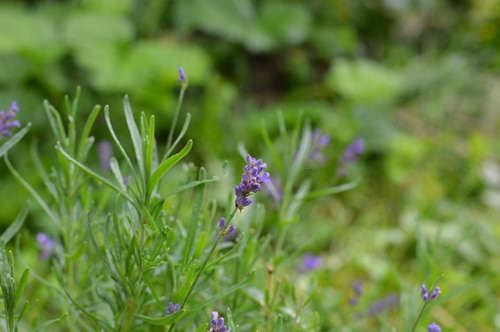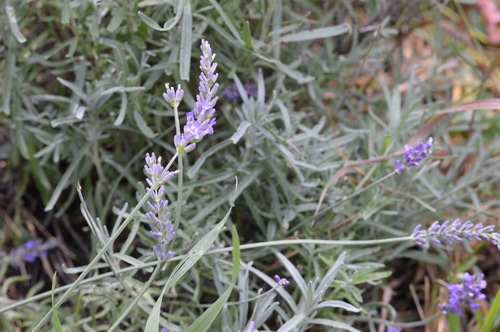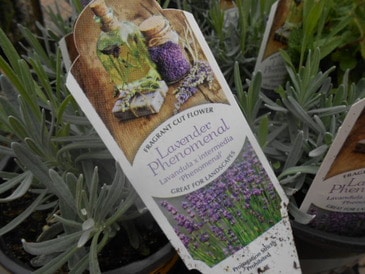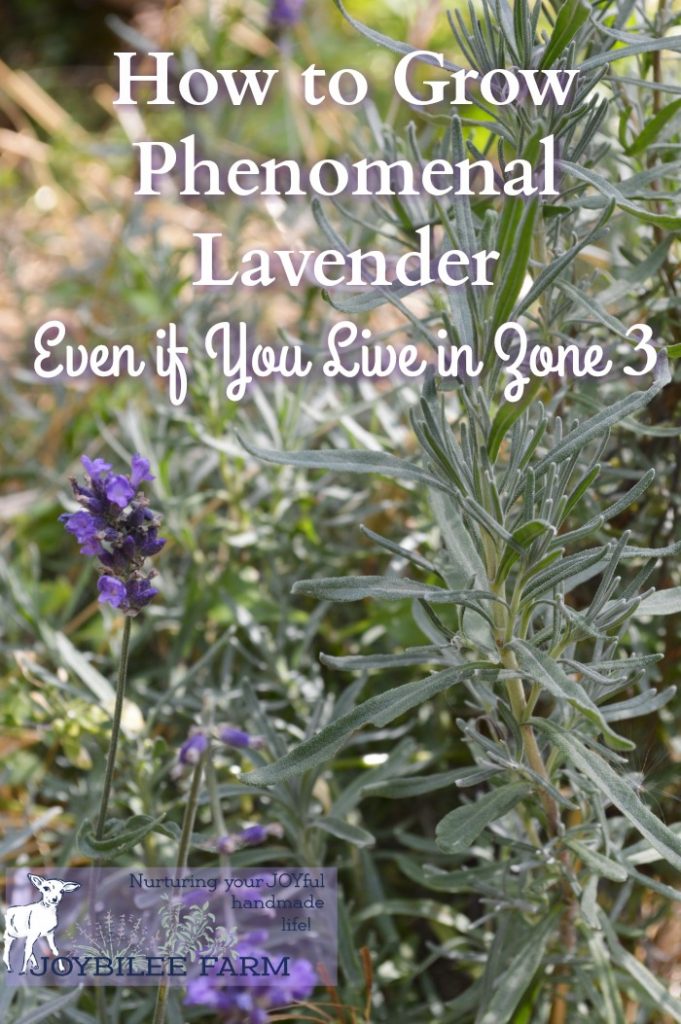Lavender is the herb I most love to grow. I love the smell. I love walking past a plant in the garden and brushing the leaves. I love that it’s practically carefree. That is it’s carefree unless you live in zone 3. Learning how to grow lavender is tricky if you live on a mountain in zone 3. But I’ve been growing lavender in the mountains of British Columbia, Canada, in zone 3 where there is frost in July. (I’m not exaggerating!) If I can grow lavender you can grow lavender. In fact, you probably can grow phenomenal lavender.
Zone 3 is on the fringes of lavender society. In town (zone 5), lavender thrives like a weed in the border of the vegetable garden but here on the mountain, my plants struggle to make it through the winter, even a mild winter. The 3-foot plants that need to be pruned in town grow only 12 inches high in my garden, with my shorter season. Thankfully, it turns out that the secret to thriving lavender in zone 3 is in the choice of varieties and a change in expectations.
Why grow lavender?
Lavender is resistant to rabbit, squirrel, and deer damage. Animals don’t like the strong scent that comes not just from the flowers, but the leaves as well. Lavender flowers and leaves can be used in the kitchen, in the apothecary, in crafts, and in aromatherapy. It is also bug repellent but it attracts butterflies and bees, offering nectar to foraging beneficial insects. It grows in specialized planting areas like under black walnut trees.
There are 4 main types of Lavender
When you are wondering which kinds of lavender will be most reliable in your growing zone, you’ll be looking at four basic types of lavender. Briefly, these are English lavender, French lavender, Lavandin which are the crosses between French and English lavender varieties, and “other lavenders” which encompasses the outliers from breeding programs, as well as wild plants.
Spike lavender, falls in this “other” category. Hardy in zones 8 to 9, it is a strongly camphorous lavender used in the soap making industry. This is the variety that is most often used for natural moth repellents. Spanish lavender is the French type, also known for its camphorous essential oil.
While none of the lavenders are toxic, if you are looking for a lavender to use in the kitchen, those with less camphor in their essential oil, are a better choice. The English lavenders have a sweeter fragrance and are more suitable for culinary use.
If you are looking for lavenders to use in sachets those with more camphor in their essential oil, will be more appropriate. These are the lavenders from the Lavandin group or the French lavender group. Those of the Lavandin group are the lavenders that are most in demand for essential oil production. The French lavender group has high camphor, considered undesirable in essential oil production. But you won’t need to worry about that since none of the French lavenders are hardy to zone 3 or 4.
Which varieties can be grown successfully in zones 3 and 4?
In zone 3 and 4, planting these 4 varieties in the border of your vegetable garden will attract butterflies and bees, while repelling varmints that you don’t want feeding in your garden. Plant “Phenomenal” at the back of the border, with Munstead and Superblue in the middle and Hidcote at the front, to take advantage of the various heights from these fragrant plants. With lavender in zone 3 or 4, you don’t have to take just one.

Munstead growing in zone 3
Munstead Lavender
Lavandula angustifolia ‘Munstead’
Munstead is an English lavender that is hardy from zones 4 to 9. If you get reliable snow cover you can grow it in zone 3, as well. It grows 12 to 18 inches tall and needs little care, other than winter protection. You can start it from seed, propagate it from stem cuttings, or get plant starts from your local nursery. Like other English lavenders, it doesn’t grow 100% true to type from seed.
Munstead has lavender-blue flowers, green, narrow leaves, and a nice lavender fragrance. It is attractive to bees. In my area, it will bloom steadily from July through to frost.
Richter’s Herbs in Ontario carries both seeds and plants for Munstead Lavender
Hidcote Lavender
Lavandula angustifolia ‘Hidcote’
Hidcote is hardy from zones 4 to 9. Like Munstead, you can get by in zone 3 with reliable snow cover or other winter protection. It has silver-grey foliage and the flowers are more purple than blue. The scent is rich, but it is a shorter plant than Munstead, only growing to 12 inches in height.
Grow Hidcote from seed, cuttings, or get plant starts from your local nursery. Richter’s Herbs also carries seeds and plants for Hidcote Lavender. Like other English lavenders, it doesn’t grow 100% true to type from seed.
Don’t confuse Hidcote Lavender with Hidcote Giant Lavender. Hidcote is an English lavender while Hidcote Giant is a lavandin (L. x intermedia).
The flower spikes on Hidcote and Munstead are not long enough to use for weaving lavender wands though. I harvest the 6-inch lavender branches after the flowers are opened and dry them upside down, indoors, away from sunlight. Once they are fully dry I rub the flowers off the stem and use the blossoms for potpourri, for tea, and for flavouring sugar and salt.
English lavender can be used in the place of rosemary for cooking and baking. Since rosemary is grown as an annual in zone 3, lavender makes a lovely substitute.

Phenomenal growing in zone 3.
Phenomenal Lavender
Lavandula x intermedia ‘Phenomenal’
Phenomenal is a hybrid introduction to the hardy lavender class, from the lavandin group. It is hardy from zone 4 to 8, as other hardy lavenders but it has the best traits of both French and English lavenders. It grows 24 to 34 inches tall, much taller than Munstead or Hidcote. It has the long flower spikes typical of hybrid lavenders with hundreds of flowers per stem. Its long stem makes it suitable for many lavender crafts that won’t work with the shorter Munstead or Hidcote varieties.

Phenomenal has silver foliage and lavender-blue flowers with a mounding habit typical of French Lavenders. It also has one of the highest essential oil contents of any lavender variety. It does well in hot, humid summers while still being hardy in winter conditions. If you are trying to recreate the French lavender fields on your homestead, this is the variety you want. It is an excellent choice for ornamental use in gardens, for fragrance, for fresh and dried arrangements, and for essential oil production. Phenomenal was featured in the March/April 2014 issue of Fine Gardening Magazine. Better Homes and Gardens named it a “Must Grow Perennial.”
Phenomenal doesn’t die back in winter. Give it some protection if you lack reliable snow cover, in zone 3.
You’ll need to find plants for this hardy hybrid lavender though. I found plants at Richter’s Herbs in Ontario. There are American sources for plants online.
Introduced in 2013 by Peace Tree Farms, unauthorized propagation is prohibited, (US PP24,193) on this American introduction to the hardy lavender class.
Superblue Lavender
(Lavandula angustifolia “Superblue”)
Superblue is a patented English Lavender from Holland (US PP#24929). It is hardy in zones 4 to 9 and can overwinter in zone 3 with protection. Superblue has deep violet-blue flowers with a compact mounding habit. Superblue is hardy and adaptable to both dryland gardening and wetter conditions. It grows 10 to 24 inches in height. Superblue is not available as seed. Plants are available from Richters.

How to grow lavender
Lavender thrives with lots of light and good air circulation. Choose a well-drained site in full sun. Check your watering patterns and don’t place lavender where it will get the irrigation from your vegetable garden. While the vegetables need a full 2 inches of water each week, lavender thrives in drier habitat and is one of these Mediterranean plants that thrive on neglect.
Prepare the soil by tilling to a depth of 6 to 8 inches. Work in some finished compost and add some potash for flower growth and root development. Work the fertilizer into the soil, or let the rain soak it in. Start your plants in pots in April, for planting out when all danger of frost is past. Plant where there is good air circulation, especially if summers are humid where you live. Lavender needs good drainage and good air circulation. Do not over-water, and allow the soil to dry before watering again.
Space Phenomenal plants 36 inches apart. Munstead and Superblue plants should be spaced 18 inches apart. Hidcote plants can get away with 12-inch spacing. Place Phenomenal at the back of a border, with Munstead or Superblue in the middle and Hidcote at the front, to take advantage of the varying spread and height of these 3 hardy lavender varieties. This means you’ll need fewer Phenomenal, than Munstead or Hidcote in a group planting.
In winter, prune back the season’s new growth by 2/3rds of the stem length. Don’t cut into old wood. If you don’t have reliable snow cover, cover the plants with straw or dry leaves and cover with burlap, to protect from drying winds and harsh weather. In Spring, remove the straw and burlap to allow air circulation, and to take advantage of the early warmth.
Don’t think you have to avoid growing lavender just because you live in an area of harsh winters or a shorter growing season. Choosing varieties suitable to your hardiness zone, and giving them full sun and a well-drained placement and you’ll be harvesting fragrant lavender for cooking, for tea, for your herbal remedies, and for crafts in a few months.
Lavender for Warmer Areas
If you live in zones 5 to 9 there are many more varieties of lavenders you can choose from. See the full selection of over 30 Lavender varieties on the Richter’s website. The rules for siting your lavender plants are the same regardless of your growing zone.
When you are ready to clip your first harvest of lavender check out these fun and useful things you can make with lavender.
Herbal remedies to make with lavender
Lavender Lotion Bars for Rough Elbows and Calloused Feet
Soothing Oatmeal and Lavender Bath Bombs
DIY Lavender Eye Pillow for Headache Relief




If you are worried about drainage for your lavender, I suggest trying it in raised beds. Usually plug trays need one more year in a pot before planting out the following spring. I’m in the same situation this year, and plan on planting out my plugs in a raised bed (a nursery bed) offering additional winter protection this year, and then transplanting them out next year in their final situation. I hope this helps.
I live in NB and am planning on planting a 1/2 acre of lavender. We are zone 4 here and I am a bit concerned about my soil. We filled rows and the soil looks great but I am worried about it being too moist. What do you suggest doing to achieve good drainage? I am looking to mound the rows and place a geo fabric on the rows. Is there anything you would suggest doing? Also… The lavender is small plug trays and I am wondering if I can plant them directly in ground when this small?
I live in Pincher Creek, south of Calgary, 30 miles east of the Rockies. We get a lot of snow and a lot of chinooks. My lavender (Munstead) comes back every year. It grows about 18 inches tall. I get two cuttings, sometimes three in a season. It is in gravelly soil and gets little water and lots of suns. Too rich soil and too much water thwart the plant’s growth and often kill it. I cut my lavender back to about one-third height in the late fall or left it over the winter to prune in the spring and have had no problems.
Hi all!
I live near Calgary Alberta where we get a fair number of chinooks over the winter, and the snow/cold isn’t always consistent. My lavender plant has done well over the summer in a pot. Unfortunately the tag that came with it doesn’t state it’s variety. I’m trying to decide if I should bring the plant indoors for winter or plant in the ground to protect and overwinter. It’s tallest stocks are maybe 18” and has lots of new growth happening.
Thanks in advance!
Hello, I live in Connecticut in zone 5b. I recently purchased some phenomenal lavender that I want to plant along our south facing wall. I was wondering how far away from the wall I should plant this variety?